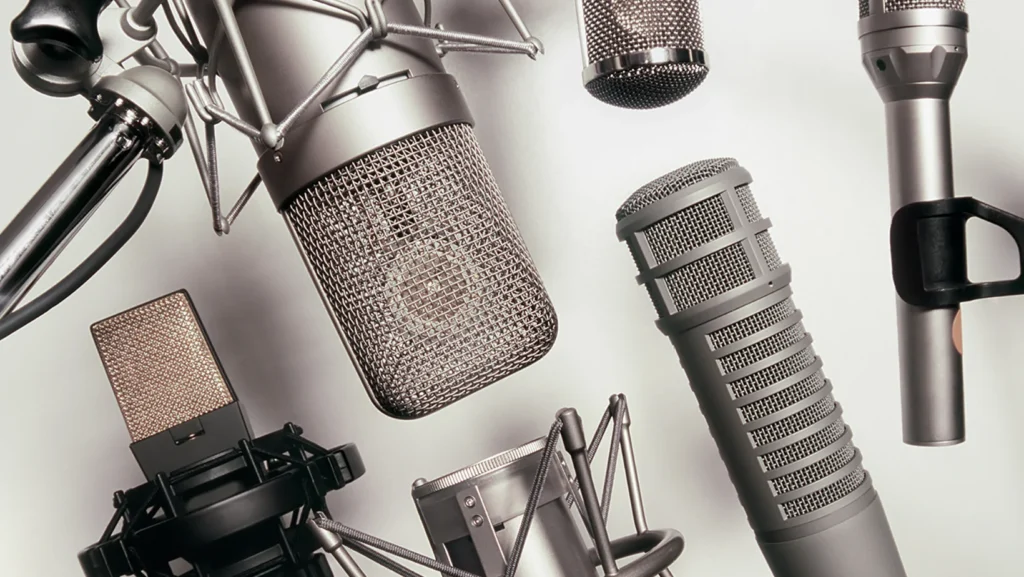In the modern business landscape, effective communication is the cornerstone of success. Clear and concise messaging is essential whether it’s engaging with clients, empowering employees, or delivering impactful presentations. This is where microphones come into play, offering a powerful tool to enhance communication within your company.
This article will delve into the four best ways to leverage microphones to their fullest potential, transforming how your company communicates and collaborates. From dynamic presentations to seamless virtual meetings, discover how microphones can elevate your company’s communication strategies and propel you toward greater success.
Are you tired of struggling to make your company’s message heard loud and clear?
Microphones offer a solution to ensure your voice cuts through the noise. Imagine captivating your audience with compelling presentations, facilitating seamless meetings with remote teams, creating immersive events that leave a lasting impression, and producing professional recordings that elevate your brand. With the right microphone setup, all of this and more is within reach.
Picture the impact of your presentations when every word resonates with clarity and authority. Envision the seamless collaboration enabled by crystal-clear audio in virtual meetings. Visualize the immersive experiences you can create for your audience at events. And consider the professionalism and expertise conveyed through high-quality recordings.
Read on to leverage microphones in the four best ways possible. Get started now!
What is a microphone and its use in business?
A microphone is a small device that listens to sound and converts it into an electrical signal. This signal can then be amplified and recorded or transmitted. In simple terms, it’s like a tiny ear that captures sound and turns it into something that computers or speakers can understand.
In business, microphones are used to make sure that people’s voices can be heard clearly. For example, in meetings, a microphone helps everyone in the room hear what the speaker is saying, even if they’re far away. In virtual meetings or presentations, microphones ensure that people tuning in online can hear the speaker too. This way, communication is smoother, and everyone can participate effectively, whether they’re in the same room or miles apart.
Did you know?
- The first real microphones formed part of the very first telephones. The soundwaves produced when speaking into the phone would make a small diaphragm vibrate, and these vibrations were then passed, via a needle, through water mixed with a little sulphuric acid.
- The Microphone market crossed the US$ 2 billion mark in 2022 and is expected to hit US$ 4 billion by 2030.
What are the 5 Advantages of the Microphone?

Here are five advantages of using microphones:
1. Amplification
Microphones capture sound and amplify it, making it louder and clearer. This ensures that even people at a distance can hear the speaker’s voice without straining.
2. Improved Communication
By using microphones in meetings, presentations, and events, communication becomes more effective. Everyone can hear and understand the speaker’s message, leading to better collaboration and decision-making.
3. Versatility
Microphones come in various types and designs, suitable for different purposes. Whether it’s a handheld microphone for speeches, a lapel microphone for hands-free operation, or a headset microphone for active presentations, there’s a microphone to fit every need.
4. Recording Capabilities
Microphones allow for the recording of audio, which can be useful for documentation, archiving, or creating content such as podcasts, training videos, or interviews. This ensures that valuable information is captured and can be revisited later.
5. Adaptability to Technology
With advancements in technology, microphones have become increasingly compatible with various devices such as computers, smartphones, and audio systems. This versatility enables seamless integration into different settings, whether it’s a traditional meeting room or a virtual conference.
Different Types of Microphones and When to use them

For business users, it’s essential to consider how microphones will be applied. Here are examples of different types of microphones suitable for various business purposes.
Dynamic Microphones:
- Description: Dynamic microphones are rugged and durable, making them suitable for live performances and environments with high sound pressure levels.
- When to Use: They are often used for stage performances, live music events, recording instruments like drums and electric guitars, and broadcasting.
- Example: Shure SM58, Sennheiser e835.
Condenser Microphones:
- Description: Condenser microphones are known for their sensitivity and ability to capture subtle nuances in sound. They require an external power source (phantom power) to operate.
- When to Use: They are commonly used in studio recordings, capturing vocals, acoustic instruments, and podcasts.
- Example: Audio-Technica AT2020, Neumann U87.
Lavalier Microphones (Lapel Microphones):
- Description: Lavalier microphones are small, discreet microphones that can be clipped onto clothing. They offer hands-free operation and are often used in presentations, interviews, and video production.
- When to Use: Ideal for situations where mobility and inconspicuousness are required, such as public speaking engagements, broadcasting, and filmmaking.
- Example: Sennheiser EW 100 G4-ME2, Rode SmartLav+.
Shotgun Microphones:
- Description: Shotgun microphones have a long, narrow pickup pattern that allows them to focus on sound coming from a specific direction while minimizing background noise.
- When to Use: They are commonly used in filmmaking, video production, and field recording to capture dialogue or sound effects while rejecting unwanted noise.
- Example: Rode NTG3, Sennheiser MKH 416.
USB Microphones:
- Description: USB microphones are designed to connect directly to a computer via USB, making them convenient for home recordings, podcasting, and video calls.
- When to Use: Perfect for content creators, podcasters, gamers, and remote workers who need a simple and portable solution for capturing audio.
- Example: Blue Yeti, Audio-Technica ATR2100x-USB.
Each type of microphone has its unique characteristics and applications, so choosing the right one depends on factors such as the intended use, environment, and desired sound quality.
Microphones for Your Business: 4 Best Ways to Utilize Microphones

In the realm of business, effective communication is paramount. Whether you’re hosting meetings, conferences, or virtual events, the utilization of microphones can significantly enhance the clarity and impact of your message.
Below are the four best ways to harness the power of microphones for your company, maximizing engagement and ensuring your message is heard loud and clear.
1. Enhanced Presentations
A high-quality microphone can transform an ordinary presentation into a captivating experience. By amplifying the speaker’s voice, microphones ensure that every member of the audience can hear and comprehend the information being shared. Whether you’re addressing a small team or a large crowd, the right microphone ensures your message resonates with clarity and authority.
2. Seamless Meetings
In today’s dynamic work environment, virtual meetings have become the norm. However, without proper audio equipment, these meetings can be plagued by echoes, background noise, and unclear dialogue. By integrating microphones into your conferencing setup, you can ensure crystal-clear audio quality, fostering seamless communication and collaboration among remote teams.
3. Immersive Events
Whether you’re hosting a corporate event, a product launch, or a seminar, microphones play a pivotal role in creating an immersive atmosphere. From handheld microphones for live Q&A sessions to wireless lapel microphones for panel discussions, the right microphone setup can captivate your audience and elevate the overall experience of your event.
4. Professional Recordings
Whether you’re creating training videos, podcasts, or promotional content, the quality of your audio can make or break the success of your project. With high-fidelity microphones, you can capture crisp, clear recordings that resonate with your audience and convey professionalism and expertise. By investing in the right microphones and recording equipment, you can ensure that your company’s audio content stands out in a crowded digital landscape.
By leveraging microphones effectively, you can elevate the quality of your company’s communication, whether it’s through presentations, meetings, events, or recordings. With the right equipment and approach, you can ensure that your message is delivered with clarity, impact, and professionalism, helping your company achieve its goals and connect with audiences on a deeper level.
Tips for using microphones effectively

Unlocking the full potential of microphones requires more than just pressing a button or holding a device. Whether you’re preparing for a crucial presentation, recording a podcast, or engaging in virtual meetings, effective microphone usage is essential for clear and impactful communication.
Here are some tips for using microphones effectively:
- Proper Placement: Position the microphone appropriately to capture clear audio. For handheld microphones, hold them close to your mouth, ensuring it’s not too close to avoid distortion. For lapel microphones, clip them securely to clothing near the mouth for optimal sound capture.
- Check Audio Levels: Before speaking, check the microphone’s audio levels to ensure they’re neither too low nor too high. Adjust the levels as needed to prevent distortion or background noise interference.
- Speak Clearly and Confidently: Enunciate your words clearly and project your voice to ensure that the microphone captures your message accurately. Avoid mumbling or speaking too quickly, which can make it difficult for the microphone to pick up your voice.
- Mind Background Noise: Be mindful of background noise that can interfere with the microphone’s performance. Choose quiet environments for recording or speaking engagements whenever possible, and minimize distractions to ensure clear audio quality.
- Monitor Feedback: Keep an ear out for feedback or unwanted noise coming from the microphone. Adjust the microphone’s position or audio settings if necessary to eliminate feedback loops and maintain clear sound quality.
- Use Windshields or Pop Filters: When recording outdoors or in environments with airflow, use windshields or pop filters to reduce unwanted noise caused by wind or plosive sounds (like “p” and “b” sounds).
- Practice Proper Handling: If using a handheld microphone, practice proper handling techniques to avoid unnecessary noise or interference. Hold the microphone steady and avoid tapping or rubbing it, which can create distracting sounds.
- Test Equipment Beforehand: Always test the microphone and audio equipment before important meetings, presentations, or recordings. This ensures everything is functioning correctly and helps you address any issues before they impact your communication.
- Seek Professional Assistance: If you’re unsure about microphone setup or usage, don’t hesitate to seek assistance from audio professionals. They can provide valuable guidance on optimizing microphone performance and ensuring high-quality audio output.
By following these tips, you can effectively harness the power of microphones to enhance your communication and ensure your message is heard loud and clear.
Important Precautions
When using microphones, it’s crucial to handle them with care to prevent damage and ensure optimal performance. Avoid dropping or mishandling microphones, as this can cause internal components to become damaged or misaligned.
Additionally, protect microphones from moisture and liquids, as exposure to water can lead to short circuits and irreversible damage. Regularly inspect cables and connections for signs of wear, and store microphones in a cool, dry place when not in use to prevent damage from temperature and humidity fluctuations.
By following these precautions, you can extend the lifespan of your microphones and maintain clear, reliable audio quality for all your communication needs.
Frequently Asked Questions About 4 Best Ways to Utilize Microphones for Your Company
Q: What are the best ways to utilize microphones for our company’s presentations?
A: Effective microphone usage can enhance presentations by ensuring clear and audible communication. Consider using handheld microphones for speakers or presenters, lapel microphones for hands-free operation, or wireless microphones for mobility. By choosing the right microphone setup and positioning, you can captivate your audience and deliver impactful presentations.
Q: How can microphones improve virtual meetings for our remote teams?
A: Microphones play a crucial role in facilitating clear communication during virtual meetings. Invest in high-quality microphones with noise-canceling features to minimize background distractions and ensure everyone’s voice is heard loud and clear. Additionally, encourage participants to use headsets or dedicated microphones to improve audio quality and eliminate echoes or feedback.
Q: What are the benefits of utilizing microphones for company events?
A: Microphones can elevate the experience of company events by enhancing audio clarity and engagement. Whether it’s a corporate conference, product launch, or team-building event, microphones enable speakers to address large audiences effectively and create immersive experiences. Consider using wireless microphones or shotgun microphones for events held in large venues to ensure coverage and optimal sound quality.
Q: How can microphones help improve the quality of our company’s recordings?
A: Choosing the right microphones and recording equipment is essential for producing professional-quality recordings. Condenser microphones are ideal for capturing detailed audio in studio settings, while dynamic microphones are suitable for live recordings or outdoor environments. Consider using USB microphones for ease of setup and compatibility with recording software, or invest in multi-channel recording systems for capturing multiple audio sources simultaneously.
Q: What should we consider when selecting microphones for our company’s needs?
A: When selecting microphones for your company, consider factors such as intended use, environment, and budget. Choose microphones that are suitable for the specific applications you require, whether it’s presentations, meetings, events, or recordings. Additionally, prioritize features such as audio quality, durability, and compatibility with existing equipment to ensure a seamless integration into your company’s workflow.
Final Thoughts
Harnessing the power of microphones offers invaluable benefits for enhancing communication and collaboration within your company. By effectively utilizing microphones in presentations, virtual meetings, events, and recordings, you can amplify your message, engage your audience, and elevate the overall quality of your communication efforts.
Whether it’s ensuring clarity and impact during presentations, fostering seamless collaboration in virtual settings, creating immersive experiences at events, or producing professional-quality recordings, microphones are indispensable tools for driving success in today’s business landscape. Embrace the opportunities afforded by strategic microphone usage and empower your company to communicate with confidence and effectiveness.

